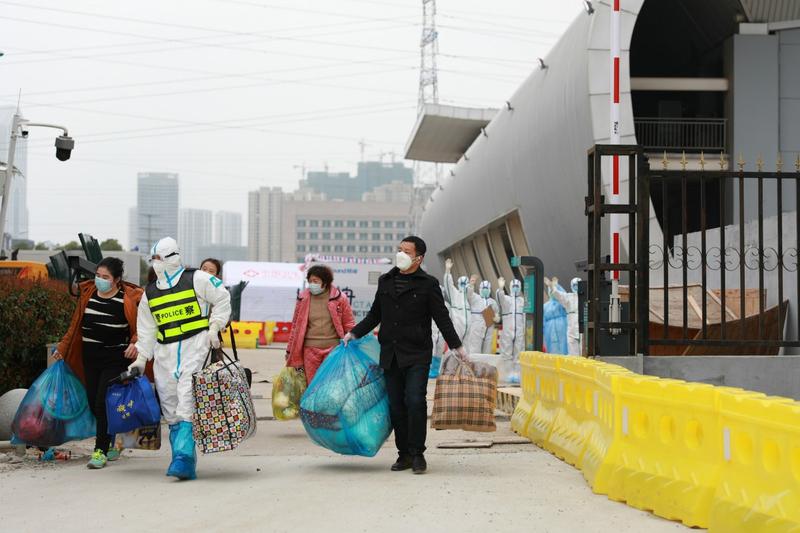 Medical staff members wave goodbye to the recovered patients at the makeshift hospital in Dongxihu district in western Wuhan, Hubei province, on March 1, 2020 (SU FENG / CHINADAILY.COM.CN)
Medical staff members wave goodbye to the recovered patients at the makeshift hospital in Dongxihu district in western Wuhan, Hubei province, on March 1, 2020 (SU FENG / CHINADAILY.COM.CN)
Hubei province added 114 new confirmed cases of novel coronavirus pneumonia on Monday, with 14 out of 17 city-level areas in the epicenter of the epidemic reporting zero new infections, according to the provincial health commission.
The slowdown in the spread of the disease coupled with a steady increase in discharged patients each day has also relieved pressure on hospitals in Wuhan, the hardest-hit city in Hubei where the pathogen emerged, as various treatment facilities have recently reported many empty beds.
The number of newly released patients had surpassed that of new confirmed cases for 13 consecutive days, the Health Commission of Hubei province said on Tuesday
By Saturday, designated hospitals in Wuhan had opened over 6,700 hospital beds; makeshift hospitals that take in mild patients had reported over 7,200 empty beds; and other quarantine and treatment centers had also found nearly 7,500 beds available, China Central Television reported.
Yang Yunyan, vice-governor of Hubei province, said at a news conference on Tuesday that as of Monday, only about 51 percent of the 7,286 beds available at 10 hospitals tasked with treating critical cases in Wuhan were occupied.
Meanwhile, 2,410 patients in Hubei were discharged on Monday. The number of newly released patients had surpassed that of new confirmed cases for 13 consecutive days, the Health Commission of Hubei province said on Tuesday.
This represents a major shift from weeks ago when overwhelmed hospitals and the exponential growth of new infections had created bottlenecks in hospital capacity, hampered timely treatment of patients and triggered the wider spread of the virus, especially in Wuhan.
To address the issue, the central leadership has decided to rapidly bolster hospital admission capacity in Wuhan by boosting the number of beds at designated hospitals to over 23,000, setting up 16 makeshift hospitals and adding over 10,000 beds at quarantine venues.
On Sunday afternoon, a makeshift hospital in Wuhan's Qiaokou district became the city's first temporary hospital to suspend operations after all patients had been either released or transferred to other medical institutions.
ALSO READ: Makeshift hospital closes after all patients recovered or moved
Another makeshift hospital in Wuhan's Jianghan district had received a high of 1,529 patients in mid-February. In recent days, the number of hospitalized people has declined to around 500, with over 100 patients being discharged from the hospital each day, Sun Hui, president of the hospital, told China Central Television on Sunday.
Ma Xiaowei, minister of the National Health Commission, said: "In hindsight, the construction of makeshift hospitals was a decision of paramount significance. Other approaches can hardly solve the acute bed shortage in such a short span."
At Leishenshan Hospital, one of two swiftly built in Wuhan, the opening up of beds had occurred as early as Feb 20, according to Wang Xinghuan, president of the hospital.
"As long as we stick with rigorous disease control work, the epidemic situation will not rebound and the rate of available beds will rise quickly," he said.
READ MORE: Official: Recovery rate of China's COVID-19 patients rising
However, Wuhan still accounts for the majority of new infections and fatalities in Hubei.
The city added 111 confirmed cases and 24 deaths on Monday. The entire province added 31 deaths.
Wuhan will gradually transfer patients at makeshift centers to designated hospitals based on the severity of their illness, and continue to strive for early treatment in order to prevent mild cases from worsening into severe infections and further reduce the mortality rate, officials have said.


